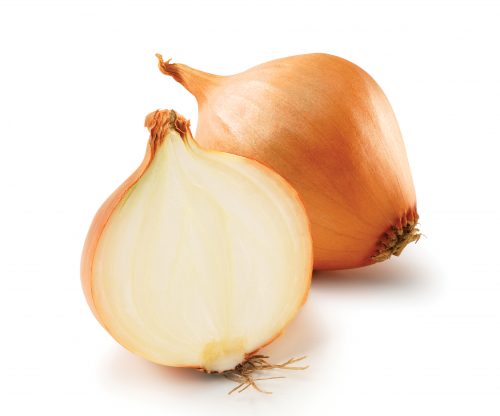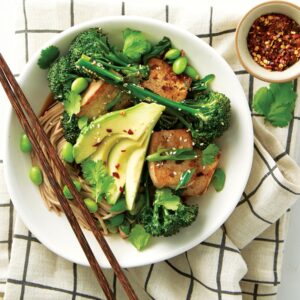
Brown onions
Seemingly ubiquitous as the base of a lot of our savoury cooking, onions can also shine as the main ingredient; think onion bhajis, French onion soup, pickled onions, caramelised onion jam… As well as the standard sautéed recipe step, onions are often used in salads and soups, sliced in rings or solid disks on burgers and chopped in relish.
Fun fact
Ancient Egyptians worshipped onions as symbols of eternal life. The concentric layers of an onion reflected the eternity of existence. Mummies have been found with onions tucked in and around the bodies. King Ramses IV, who died in 1160 BC, is said to have been found with onions inserted into his eye sockets.
Nutrition facts
Brown onions are a good source of antioxidants and sulphur-containing nutrients. If you’re having problems with FODMAP foods, you might know that onions contain a type of carbohydrate called ‘fructans’. If you don’t have FODMAP issues, then these fructans are a good source of food for your gut bacteria.
Recipe ideas
Spicy egg dhal with chilli and garlic oil
Lamb cacciatore
French onion soup
Pears
In our diet, pears have been treated like the quiet cousin of the apple, an alternative piece of fruit in the lunchbox. But with evidence of them being eaten since prehistoric times, pears are significant in their own right. They are juicy, delicious and versatile, both cooked and raw.
There are two main types of eating pear (only 30 of the 4000 recorded types of pear tree bear edible fruit), European and Asian. European pears are the most common in our gardens and shops, smooth-skinned and usually bell shaped, with the flavour we all know and love. Nashi pears are more like apples in appearance and aren’t pear-like in shape. The skin’s texture is a little gritty and the flesh isn’t especially juicy (relatively speaking) and has a crispness that borders on crunchy and, unlike many fruits, the Asian pear is firm when it’s ripe, so eating it raw and in salads and slaws makes the best of its characteristics.
Did you know?
Our local NZ variety, Taylor’s Gold, is a good pear for making jams, jellies and sauces. Winter Nelis and Beurre Bosc are two of the most common European pear varieties grown in New Zealand.
Nutrition fact
When eaten with the skin, pears are a good source of fibre; one pear can contribute 4g to your daily fibre requirements. Pears can be a trigger food for digestive problems if you have FODMAP issues.
Recipe ideas
Pear, quinoa, date and vanilla slice
Pear and parsnip soup
Chinese (napa) cabbage
Chinese (napa, wombok or celery) cabbage differs from head cabbages, with long, light green leaves that flower off thick white stalks, looking a bit like a romaine lettuce. It has a lovely mild flavour with a peppery kick that is delicious in salads, soups, slaws, stir-fries and dumpling fillings. It is also great for spicy kimchi and sauerkraut.
Try this
Toss chopped cabbage, Chinese mushrooms and carrots in a chilli-garlic-vinegar sauce and serve as a side. Wrap whole cabbage leaves around a filling of brown rice and minced pork, cover with sweet and sour sauce and bake until tender.
Nutrition facts
Chinese cabbage is a good source of folate and an excellent source of vitamins C and K. Like other cabbages, Chinese cabbage is rich in antioxidants and sulphur-containing nutrients that can help reduce the risk of cancer.
Recipe ideas
Lemongrass fish parcels with shredded cabbage salad
Marinated chicken with Asian coleslaw
Fresh this month
(Harvested in New Zealand gardens in May)
Vegetables: Beetroot, broccoli, Brussels sprouts, cabbage, carrots, cauliflower, celeriac, celery, chillies, cucumber, eggplant, Jerusalem artichokes, kale, kumara, onions, parsnips, pumpkin, radishes, shallots, silver beet, spinach, spring onions, squash, swede, turnips, watercress
Herbs: Basil, chives, coriander, dill, marjoram, mint, oregano, parsley, rosemary, sage, thyme
Fruit: Apples, feijoas, figs, grapes, grapefruit, kiwifruit, lemons, limes, mandarins, passionfruit, quinces, rhubarb, tamarillos, tangerines
www.healthyfood.com










